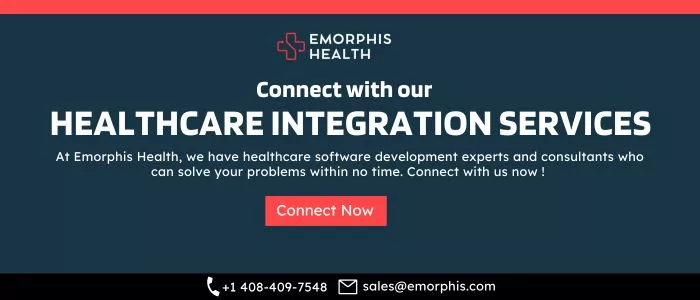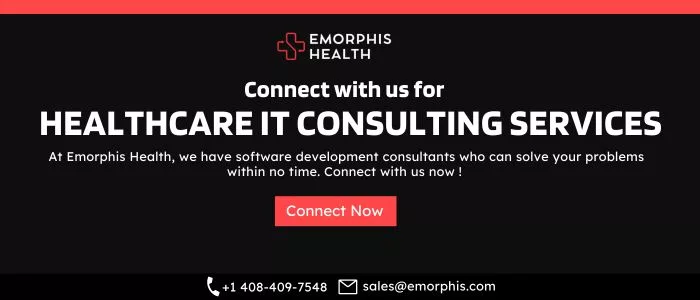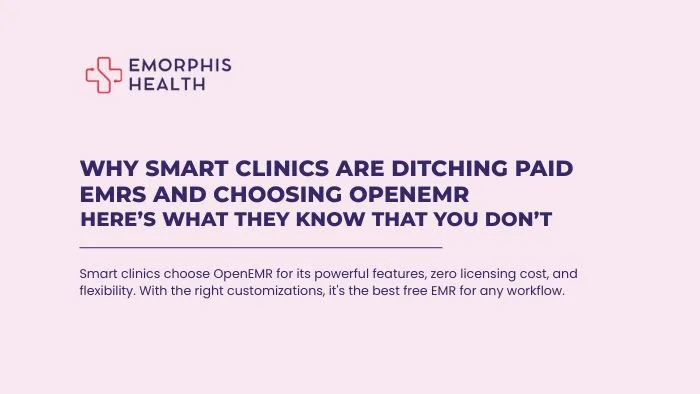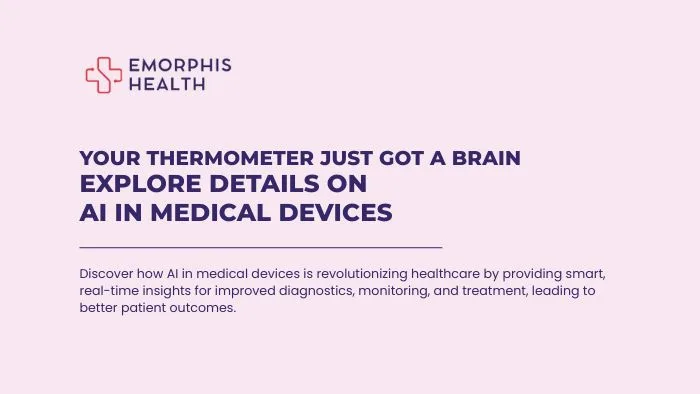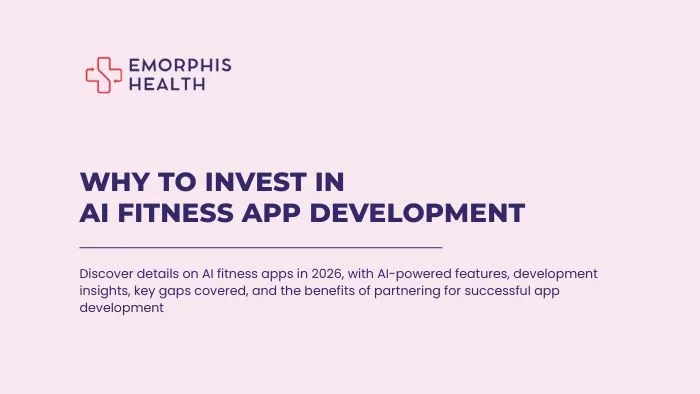Overview
See Contents
- 1 Overview
- 2 Understanding mHealth Applications
- 3 Understanding EMR system
- 4 The Need for Integration: Bridging the Gap between mHealth and EMR Systems
- 5 Benefits of Mobile Health (mHealth) Integration with EMR Systems
- 6 Key Considerations Before mHealth Integration
- 7 Standardization in Data Exchange for Integrating mHealth with EMR Systems
- 8 A Step-by-Step Guide to Implementing mHealth Integration with EMR Systems
- 9 Strategies and Solutions to Overcome Interoperability Issues in mHealth Integration with EMR Systems
- 10 Future Trends and Innovations in Healthcare Technology – Paving the Way for Connected Healthcare
- 11 Predictions for the Future of Connected Healthcare
- 12 Conclusion
The symbiotic relationship between mHealth and EMR systems epitomizes the transformative journey of healthcare in the digital age. The fusion of patient-centric technologies, facilitated by EMR integration, paves the way for a future where personalized, data-driven care is not just a possibility but a healthcare reality. As we navigate this dynamic landscape, the seamless flow of information between mHealth applications and EMR systems heralds a new era of interconnected, efficient, also patient-focused healthcare.
Understanding mHealth Applications
In the dynamic realm of healthcare, the advent of mHealth applications has catalyzed a paradigm shift in patient engagement and healthcare delivery. In fact, these applications seamlessly integrate into our daily lives, revolutionizing how we monitor and manage our health.
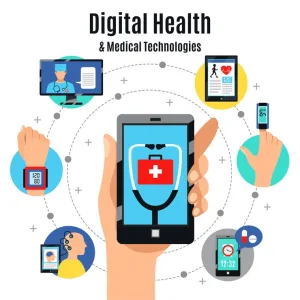
To comprehend the impact of mHealth applications, one must first recognize their multifaceted nature. As a matter of fact, these innovative mHealth Applications tools, accessible via smartphones and other mobile devices, serve as personalized gateways to health management. Moreover, transitioning beyond mere fitness trackers, mHealth applications encompass a wide array of functionalities, ranging from medication adherence and symptom tracking to virtual consultations and personalized wellness plans.
Undoubtedly, the versatility of mHealth applications is a testament to their adaptive nature. Moreover, users can seamlessly navigate between features, ensuring a holistic approach to health and well-being. Moreover, the user-friendly interfaces of these applications foster a sense of empowerment, empowering individuals to actively participate in their healthcare journey.
The Pinnacle: Wearables and Sensors
Elevating the mHealth experience to new heights are wearables and sensors, that serve as indispensable companions in our daily lives. Wearables, including smartwatches and fitness trackers, transcend mere fashion statements, also, becoming veritable health hubs strapped to our wrists. In fact, these devices, equipped with an arsenal of sensors, meticulously capture real-time data, creating a continuous stream of health insights.
Types of data collected through mHealth Applications
A rich tapestry of health-related information unfolds through mHealth applications, solutions, or technologies. From basic metrics like heart rate and step counts to more nuanced indicators such as sleep patterns also stress levels, these applications create a comprehensive mosaic of an individual’s well-being.
Transitioning beyond the superficial, these applications delve into a plethora of data points, encompassing both fundamental and nuanced metrics, in fact, each contributing to the holistic understanding of health.
However, the beauty of mHealth applications lies in their ability to go beyond the basics. With an artful precision, these technologies capture nuanced indicators that add depth to the narrative. Sleep patterns, for instance, unfold as a delicate brushstroke, revealing the quality and duration of rest crucial for overall health. Stress levels, akin to a subtle melody, offer insights into the psychological aspects of well-being, completing the symphony of data.
Transitioning smoothly from one data point to another, mHealth applications facilitate an interconnected understanding of health. This holistic approach empowers healthcare professionals with a panoramic view, enabling them to decipher patterns, also, identify correlations, and make informed decisions that transcend the limitations of isolated data points.
The types of data collected through mHealth applications encapsulate both the art and science of health insights. In fact, from the fundamental metrics that lay the groundwork to the nuanced indicators that add depth, the symphony of data paints a comprehensive portrait of an individual’s well-being. As technology continues to evolve, the mastery lies not only in the collection but in the orchestration of this data, also, transforming it into a tool that empowers individuals and enhances the art of healthcare delivery.
Understanding EMR system
In the digital age, the EMR system serves as a pioneer leading the healthcare sector into an era where information flows seamlessly across the digital landscape.
Key Features: Unlocking the Power of Digitalization
As a matter of fact, at the heart of the EMR system lie key features that unlock the true potential of digitalization in healthcare. Like assembling a complex puzzle, the components of an EMR system seamlessly fit together, also, creating a comprehensive picture of patient health.
Patient demographics, medical history, and treatment plans become interconnected pieces, also, forming a cohesive narrative that healthcare professionals can access and update in real-time. Moreover, these systems facilitate enhanced communication among healthcare providers, reduce errors, and pave the way for data-driven decision-making, ultimately leading to improved patient outcomes and a more efficient healthcare delivery model.
EMR system boasts key features that propel healthcare into the digital era. Interoperability serves as the bedrock, fostering connectivity also information exchange across different healthcare providers.
Moreover, real-time data entry ensures that patient information remains current and accessible, facilitating timely decision-making. Intelligent decision support tools embedded in EMR systems guide healthcare professionals, reducing errors also aligning practices with the latest clinical guidelines.
Whereas robust security measures, including encryption and access controls, safeguard patient confidentiality and comply with privacy standards, the customization options also templates cater to diverse medical specialties, allowing for a tailored user experience.
Furthermore, seamless integration with ancillary systems, such as laboratory information systems, enhances the comprehensiveness of patient care.
In essence, the tapestry of these key features not only streamlines workflows and improves efficiency but also contributes to a patient-centric and interconnected healthcare landscape.
The Need for Integration: Bridging the Gap between mHealth and EMR Systems
In the ever-evolving landscape of healthcare, the synergy between mHealth and Electronic Medical Record (EMR) systems holds immense promise. However, a crucial gap exists between these two realms, hindering the seamless exchange of information.
The imperative for integration becomes evident as the linchpin that connects mHealth applications, wearables, and sensors with the comprehensive data repositories housed within EMR systems. This integration not only enhances data accuracy but also ensures that the valuable insights gleaned from mHealth technologies seamlessly contribute to the comprehensive patient health records stored in EMR systems.
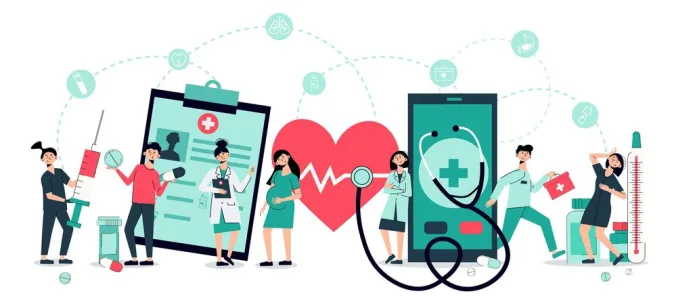
Streamlining Healthcare Workflows for Better Outcomes
At the core of the healthcare system’s efficiency lies the need for streamlined workflows. The integration of mHealth and EMR systems acts as a transformative force, mitigating the challenges posed by disparate data sources and fostering a harmonious flow of information. Moreover, this streamlined approach ensures that healthcare professionals can access and utilize real-time data seamlessly, leading to more informed decision-making.
As a matter of fact, by bridging the gap between mHealth and EMR systems, integration becomes the catalyst for a more efficient and interconnected healthcare ecosystem, ultimately translating into better outcomes for patients. The unified approach offered by healthcare integration optimizes healthcare workflows, also allowing for a more cohesive and patient-centric delivery of care.
Explore our offerings in EMR and EHR Integration Services
Benefits of Mobile Health (mHealth) Integration with EMR Systems
The integration of Mobile Health (mHealth) with Electronic Medical Record (EMR) systems heralds a new era in healthcare, bringing forth a host of transformative benefits that resonate across the spectrum of patient care and clinical management.
-
Enhanced Data Accuracy and Accessibility
Integrating mHealth with EMR systems ensures a seamless exchange of real-time data. Patient-generated information from mHealth applications, wearables, and sensors becomes an integral part of the comprehensive patient records stored in EMR systems. This not only enhances the accuracy of health data but also provides healthcare professionals with timely and accessible information critical for making informed decisions.
-
Comprehensive Patient Profiles
The synergy between mHealth and EMR systems contributes to the creation of comprehensive patient profiles. By consolidating data from various sources, healthcare providers gain a holistic understanding of a patient’s health journey. This comprehensive view facilitates more personalized and targeted interventions, ultimately improving the quality of care and patient outcomes.
-
Improved Care Coordination and Communication
Integration fosters seamless communication and coordination among healthcare teams. The interconnected data from mHealth applications and EMR systems enable healthcare professionals to collaborate more efficiently, leading to better-coordinated care plans. This enhanced communication ensures that all stakeholders are on the same page, reducing the risk of errors and improving overall patient safety.
-
Empowering Patient Engagement
The integration of mHealth and EMR systems empowers patients to participate in their healthcare journey actively. Patients can contribute real-time health data, monitor their progress, and engage with healthcare providers through mHealth applications. This active involvement enhances patient engagement, encourages adherence to treatment plans, and promotes a sense of ownership over one’s health.
-
Streamlined Workflows and Increased Efficiency
Efficiency in healthcare workflows is a cornerstone benefit of mHealth integration with EMR systems. The seamless flow of data between these platforms reduces the burden of manual data entry, minimizing the risk of errors and improving overall operational efficiency. This streamlined workflow allows healthcare professionals to focus more on patient care and less on administrative tasks.
-
Facilitation of Remote Monitoring and Telehealth Services
The integration facilitates the implementation of remote monitoring and telehealth services. mHealth technologies, when seamlessly integrated with EMR systems, enable healthcare providers to monitor patients remotely, offer virtual consultations, and adjust treatment plans in real-time. This not only improves access to care, especially for individuals in remote locations but also enhances the overall efficiency of healthcare delivery.
Overall, the benefits of integrating mHealth with EMR systems are multifaceted, ranging from improved data accuracy and patient engagement to streamlined workflows and enhanced care coordination. As healthcare continues to embrace digital transformation, this integration emerges as a cornerstone for delivering more effective, patient-centric, and interconnected healthcare services.
Key Considerations Before mHealth Integration
Before seamlessly integrating Mobile Health (mHealth) technologies with existing Electronic Medical Record (EMR) systems, several critical considerations should be carefully evaluated.
Firstly, an in-depth assessment of the compatibility of existing EMR systems is crucial. This involves scrutinizing the infrastructure and interfaces to identify potential points of integration.
Concurrently, mHealth technologies must be rigorously evaluated based on their integration potential. This includes scrutinizing data formats, communication protocols, and security features to ensure seamless alignment with existing EMR systems.
Subsequently, conducting compatibility testing and pilot programs allows for practical assessments, fine-tuning integration protocols, and gauging real-world effectiveness.
Moreover, ensuring data security and compliance becomes paramount, necessitating the implementation of robust encryption and access controls to safeguard patient information.
Furthermore, comprehensive user training and adoption strategies are essential to facilitate seamless integration and harness the full potential of the integrated system. Anticipating future needs and scalability is equally critical, emphasizing the importance of selecting technologies that can adapt to emerging trends and ensure a sustainable solution in the long run.
In navigating these key considerations, healthcare organizations can pave the way for a successful mHealth integration that enhances patient care and optimizes healthcare workflows.
Standardization in Data Exchange for Integrating mHealth with EMR Systems
Integrating Mobile Health (mHealth) technologies with existing Electronic Medical Record (EMR) systems in fact, necessitates a meticulous adherence to standardized data exchange protocols.
Embracing Health Level Seven (HL7) standards, notably HL7 v2 and HL7 v3, becomes foundational for consistent messaging and information exchange. In fact, the adoption of Fast Healthcare Interoperability Resources (FHIR) facilitates a modern, flexible approach, leveraging RESTful APIs and resource-oriented principles for efficient data exchange. As a matter of fact, for comprehensive clinical documents, adherence to Clinical Document Architecture (CDA) standards ensures structured and standardized information transfer in XML format. Consistency in terminology and code sets, aligned with vocabularies such as SNOMED CT or LOINC, also becomes imperative for a shared understanding of health data.
Furthermore, prioritizing security and privacy standards, such as those defined by HIPAA, in fact, safeguards patient information during transmission. Moreover, a strategic embrace of data interoperability frameworks, including those outlined by Integrating the Healthcare Enterprise (IHE), offers a roadmap for achieving seamless interoperability.
In amalgamating these standardized approaches, as a matter of fact, healthcare organizations lay the groundwork for a unified, interoperable ecosystem that enhances data accuracy, streamlines workflows, and ultimately improves patient outcomes.

A Step-by-Step Guide to Implementing mHealth Integration with EMR Systems
-
Needs Assessment and Planning
- Begin by conducting a comprehensive needs assessment to identify specific integration goals, such as improving patient engagement or streamlining workflows.
- Define the scope of mHealth integration and establish key performance indicators (KPIs) to measure success.
- Develop a detailed project plan outlining timelines, resource requirements, and stakeholder involvement.
-
Compatibility Analysis
- Assess the existing Electronic Medical Record (EMR) systems for compatibility with mHealth technologies.
- Evaluate the capabilities of mHealth applications, wearables, and sensors to ensure they align with integration goals.
- Identify potential challenges and areas for customization to achieve seamless compatibility.
-
Standardization Alignment
- Choose appropriate data exchange standards, such as HL7, FHIR, or CDA, based on the integration requirements.
- Ensure that both mHealth technologies and EMR systems adhere to the selected standards to promote interoperability.
- Establish consistent terminology and code sets for accurate data interpretation.
-
Security and Privacy Compliance
- Prioritize data security and privacy by implementing encryption, secure data transmission protocols, and access controls.
- Align the integration with relevant regulatory standards, such as HIPAA, to safeguard patient information.
- Conduct thorough risk assessments to identify and address potential security vulnerabilities.
-
Technology Selection and Configuration
- Select integration-friendly technologies that support the chosen standards and protocols.
- Configure mHealth applications and EMR systems to enable seamless data exchange, ensuring proper API configurations and data mapping.
- Implement necessary software updates and patches to maintain system compatibility.
-
Pilot Testing
- Execute a pilot program to validate the integration in a controlled environment.
- Monitor data exchange processes, identify any issues, and gather feedback from end-users.
- Adjust configurations and address issues identified during the pilot phase to optimize performance.
-
User Training and Adoption
- Develop a comprehensive training program for healthcare professionals and staff to familiarize them with the integrated system.
- Provide ongoing support and resources to ensure a smooth transition and encourage user adoption.
- Gather feedback from end-users to identify areas for additional training or system improvements.
-
Data Monitoring and Optimization
- Implement monitoring tools to track the performance of the integrated system continuously.
- Monitor data quality, identify trends, and address any anomalies promptly.
- Continuously optimize the integration based on user feedback, system performance, and evolving healthcare needs.
-
Scale-Up and Expansion
- Gradually scale up the integration to include additional functionalities, departments, or healthcare facilities.
- Assess the scalability of the integrated system to accommodate growing data volumes and user demands.
- Explore opportunities for expanding mHealth integration to enhance overall healthcare delivery.
-
Continuous Improvement
- Establish a continuous improvement framework to regularly assess the effectiveness of the integration.
- Solicit feedback from stakeholders, conduct regular reviews, and stay informed about emerging technologies or standards.
- Iterate on the integration based on lessons learned and evolving healthcare requirements.
By following this step-by-step guide, healthcare organizations can systematically implement mHealth integration with EMR systems, fostering an interconnected healthcare ecosystem that enhances patient care, improves workflows, and embraces the benefits of digital transformation.

Strategies and Solutions to Overcome Interoperability Issues in mHealth Integration with EMR Systems
Adoption of Standardized Protocols
- Strategy: Ensure that mHealth technologies and EMR systems use standardized data exchange protocols such as HL7, FHIR, or CDA.
- Solution: Implementing protocols that are universally accepted in the healthcare industry promotes seamless interoperability by providing a common language for data exchange.
Use of Health Information Exchanges (HIEs)
- Strategy: Leverage Health Information Exchanges to facilitate the secure sharing of patient data among different healthcare entities.
- Solution: HIEs act as intermediaries, enabling interoperability by harmonizing data formats and standards, and ensuring efficient and secure information exchange.
API Integration and Middleware Solutions
- Strategy: Implement Application Programming Interface (API) integration to establish a direct connection between mHealth applications and EMR systems.
- Solution: Middleware solutions can act as connectors, translating data formats and facilitating communication between disparate systems, ensuring a smooth and standardized integration process.
Data Mapping and Terminology Normalization
- Strategy: Establish a consistent approach to data mapping and terminology normalization between mHealth and EMR systems.
- Solution: Utilize mapping tools and standardized terminologies (e.g., SNOMED CT) to ensure that data elements are interpreted uniformly, overcoming discrepancies in data representation.
Interoperability Testing
- Strategy: Prioritize thorough interoperability testing during the implementation phase.
- Solution: Conduct rigorous testing to identify and address potential integration issues, ensuring that data flows seamlessly between mHealth technologies and EMR systems.
Establishing Data Governance Frameworks
- Strategy: Develop robust data governance frameworks to define data standards, quality measures, and ownership responsibilities.
- Solution: Clearly defined governance structures ensure that data is consistently managed and interpreted, fostering interoperability by providing a standardized approach to data handling.
Collaboration and Stakeholder Engagement
- Strategy: Foster collaboration among healthcare stakeholders, including providers, vendors, and regulatory bodies.
- Solution: Engage in open communication to address challenges collaboratively, share best practices, and collectively work towards standardized solutions that enhance interoperability.
Continuous Education and Training
- Strategy: Prioritize ongoing education and training for healthcare professionals on the nuances of interoperability.
- Solution: Ensure that users are well-versed in standardized protocols, data mapping techniques, and the overall integration process to minimize errors and promote a culture of interoperability.
Alignment with National and Global Standards
- Strategy: Align mHealth integration efforts with national and global healthcare standards.
- Solution: Adhering to established standards ensures that integration solutions are compatible on a broader scale, fostering interoperability not only within the organization but also across the healthcare ecosystem.
Scalability and Future-Proofing
- Strategy: Implement solutions that are scalable and adaptable to future changes in healthcare technology and standards.
- Solution: Choosing technologies and protocols that can evolve with emerging trends ensures that the integration remains effective and interoperable in the face of future developments.
By implementing these strategies and solutions, in fact, healthcare organizations can overcome interoperability challenges, creating a cohesive and interconnected ecosystem where mHealth technologies seamlessly integrate with existing EMR systems, ultimately enhancing patient care and optimizing healthcare delivery.
Future Trends and Innovations in Healthcare Technology – Paving the Way for Connected Healthcare
In the dynamic landscape of healthcare technology, a multitude of emerging technologies in both Mobile Health (mHealth) and Electronic Medical Records (EMR) are reshaping the future of patient care.
-
Artificial Intelligence (AI) and Machine Learning (ML)
- mHealth: AI-driven health apps analyze vast datasets from wearables, predicting health trends and also offering personalized insights.
- EMR: ML algorithms enhance EMR systems by predicting potential health issues, in fact, improving diagnosis accuracy, and optimizing treatment plans.
-
Internet of Things (IoT)
- mHealth: IoT devices, such as smartwatches and connected home health monitoring tools, in fact, offer real-time health data for continuous remote monitoring.
- EMR: Integration of IoT devices with EMR systems enables the seamless flow of data, also providing a comprehensive view of a patient’s health status.
-
Blockchain Technology
- mHealth: Blockchain ensures the security and integrity of health data, in fact, allowing patients to have control over their information.
- EMR: Implementing blockchain in EMR systems enhances data security, also, transparency, and interoperability among healthcare providers.
-
Telemedicine and Virtual Health Platforms
- mHealth: Telemedicine apps and virtual health platforms enable remote consultations, in fact, providing convenient access to healthcare services.
- EMR: Integration with telemedicine platforms enhances EMR systems, in fact, enabling the seamless exchange of patient information between virtual and physical healthcare settings.
-
Augmented and Virtual Reality (AR/VR)
- mHealth: AR/VR applications provide immersive experiences for patient education, mental health interventions, and therapeutic purposes.
- EMR: AR/VR is integrated into medical training within EMR systems, offering interactive simulations and enhancing medical education.
Predictions for the Future of Connected Healthcare
-
Interconnected Ecosystems
Healthcare systems will move towards a fully interconnected ecosystem, where mHealth devices, wearables, and EMR systems seamlessly exchange data to provide a holistic view of patient health.
-
Patient-Centric Care
The future will witness a shift towards more patient-centric care models, with individuals actively engaging in their health using mHealth applications and having greater control over their health data.
-
Predictive Analytics and Preventive Care
AI and predictive analytics in both mHealth and EMR will play a pivotal role in identifying potential health risks early, enabling healthcare providers in fact, to focus on preventive interventions.
-
Continuous Remote Monitoring
Continuous remote monitoring through mHealth devices and IoT will become standard practice, also allowing healthcare professionals to monitor patients in real-time and intervene promptly when needed.
-
Enhanced Data Interoperability
Improved data interoperability standards will facilitate seamless communication between mHealth apps and EMR systems, reducing data silos and enhancing collaborative care.
-
Wearable Health Tech Integration
Wearable health technologies will be deeply integrated into EMR systems, in fact, allowing for a more comprehensive analysis of patient-generated health data and improving clinical decision-making.
-
Personalized Treatment Plans
The convergence of genetic data, mHealth insights, and EMR information will lead to more personalized treatment plans, also optimization of therapeutic approaches based on individual patient profiles.
-
Ethical Use of Health Data
Future advancements will emphasize ethical considerations in the use of health data, also ensuring transparency, consent, and patient privacy are prioritized in connected healthcare ecosystems.
As we journey into the future, the synergy between mHealth and EMR technologies is poised to redefine healthcare delivery, creating a connected and patient-centric paradigm that leverages the full potential of emerging technologies to improve health outcomes and elevate the overall quality of care.
Conclusion
In the synthesis of Mobile Health (mHealth) and Electronic Medical Record (EMR) systems, our exploration has uncovered the dynamic interplay between emerging technologies, in fact, the intricacies of integration, and the promising future of connected healthcare.
From dissecting the granularity of mHealth applications to unraveling the key features of EMR systems, as a matter of fact, we navigated the need for integration as a catalyst for improved healthcare outcomes. Also, strategies to overcome interoperability challenges laid the groundwork for a seamless merger, emphasizing standardized protocols and collaborative governance.
As we gaze into the future, the vision unfolds, in fact, an interconnected healthcare landscape where personalized treatment plans, predictive analytics, and ethical data use converge to redefine the patient experience. The synergy between mHealth and EMR systems represents not just a technological fusion but also a paradigm shift, promising a future where technology nurtures a more compassionate, patient-centric, and interconnected healthcare environment.
Connect with Emorphis Health for more details.



